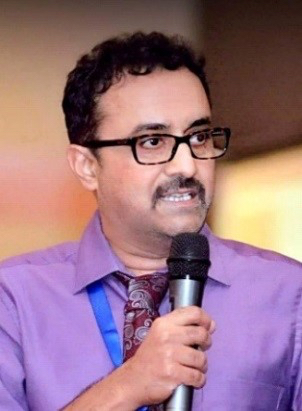IEEE NTC Chicago Chapter Seminar: Tuning Magnetic Anisotropy in Nanostructures for Biomedical and Electromagnetic Applications
The seminar will feature IEEE Magnetic Society Distinguished Lecturer, Prof. Hari Srikanth. The seminar will be held at Argonne National Laboratory.
Please check site access requirements for Argonne: https://www.anl.gov/visiting-argonne
Date and Time
Location
Hosts
Registration
- Date: 19 Sep 2019
- Time: 11:00 AM to 12:00 PM
- All times are (UTC-05:00) Central Time (US & Canada)
-
 Add Event to Calendar
Add Event to Calendar
- Contact Event Host
- Co-sponsored by Valentine Novosad
Speakers
 Prof. Hari Srikanth of University of South Florida
Prof. Hari Srikanth of University of South Florida
Tuning Magnetic Anisotropy in Nanostructures for Biomedical and Electromagnetic Applications
Magnetic nanoparticles have been building blocks in applications ranging from high density recording to spintronics and nanomedicine [1]. Magnetic anisotropies in nanoparticles arising from surfaces, shapes, and interfaces in hybrid structures are important in determining the functional response in various applications. In this talk I will first introduce the basic aspects of anisotropy and discuss resonant radio-frequency (RF) transverse susceptibility, which we have used extensively, as a powerful method to probe the effective anisotropy in magnetic materials. The tuning of anisotropy has a direct impact on the performance of functional magnetic nanoparticles in biomedical applications such as contrast enhancement in magnetic resonance imaging and magnetic hyperthermia for cancer therapy. I will focus on the role of tuning surface and interfacial anisotropy with a goal to enhance specific absorption rate or heating efficiency. Strategies going beyond simple spherical structures to include exchange coupled core-shell nanoparticles, nanowires, and nanotubes, can be exploited to increase heating efficiency in magnetic hyperthermia [2], [3]. In addition to biomedical applications, composites of anisotropic nanoparticles dispersed in polymers pave the way to a range of electrically and magnetically tunable materials for RF and microwave device applications [4]. This lecture will combine insights into fundamental physics of magnetic nanostructures along with recent research advances in their application to nanomedicine and electromagnetic devices.
[1] E. A. Périgo, G. Hemery, O. Sandre, D. Ortega, E. Garaio, F. Plazaola, and F. J. Teran, “Fundamentals and advances in magnetic hyperthermia,” Appl. Phys. Rev., vol. 2, 041302, 2015.
[2] Z. Nemati, J. Alonso, H. Khurshid, M. H. Phan, and H. Srikanth, “Core/shell iron/iron oxide nanoparticles: Are they promising for magnetic hyperthermia?” RSC Advances, vol. 6, 38697, 2016.
[3] H. Khurshid, M.-H. Phan, P. Mukherjee, and H. Srikanth, “Tuning exchange bias in Fe/g-Fe2O3 core-shell nanoparticles: Impacts of interface and surface spins,” Appl. Phys. Lett., vol. 104, 072407, 2014.
[4] K. Stojak, S. Pal, H. Srikanth, C. Morales, J. Dewdney, T. Weller, and J. Wang, “Polymer nanocomposites exhibiting magnetically tunable microwave properties,” Nanotechnology, vol. 22, 135602, 2011.
Biography:
Hari Srikanth is a professor of physics at the University of South Florida (USF). He received the Ph.D. in experimental condensed matter physics from the Indian Institute of Science. After postdoctoral research for several years, he joined USF in 2000, where he established the Functional Materials Laboratory. His research spans a wide range of topics including magnetic nanoparticles, magnetic refrigerant materials, spin calorics, and complex oxides. He has published about 250 journal articles and given numerous invited talks. Dr. Srikanth is a Fellow of the American Physical Society and a Senior Member of IEEE. He is an associate editor of the Journal of Applied Physics. He has been closely involved with the Magnetism and Magnetic Materials and INTERMAG conferences for more than 15 years, serving as editor, publications chair, and as a member of program committees.
